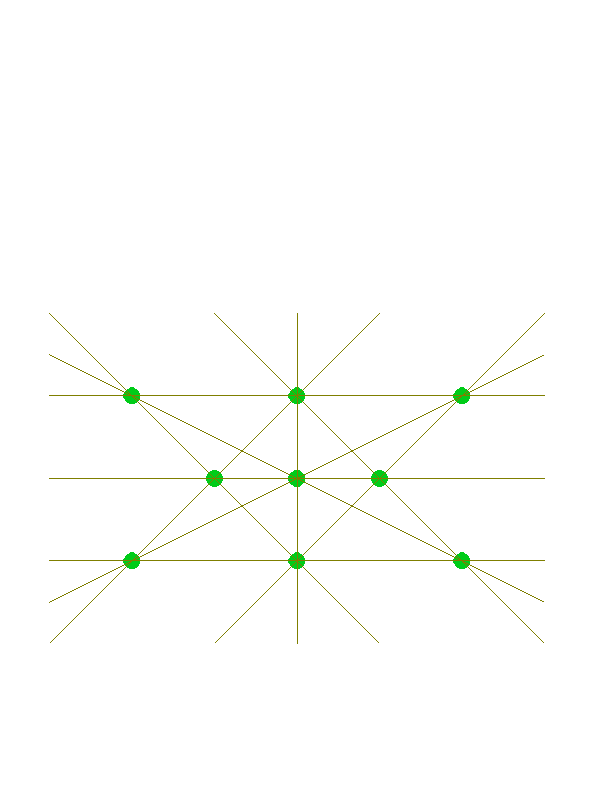
Puzzle 1: If you start with a 3 by 3 square that has 8 lines, you can easily modify it to create 10 lines by sliding the four corner points left and right. Now we have 3 horizontal lines, 1 vertical, and the 2 diagonals; we've lost two vertical lines, but we've gained 4 new lines that join the corner points, an endpoint of the middle row, and the middle of the top or bottom row.

Here is a table based on Gruenbaum, giving the number of trees, and the maximum number of rows of 3 that can be produced. Values which are not known to be the best have a question mark.
| Number of trees | Rows of 3 |
|---|---|
| 3 | 1 |
| 4 | 1 |
| 5 | 2 |
| 6 | 4 |
| 7 | 6 |
| 8 | 7 |
| 9 | 10 |
| 10 | 12 |
| 11 | 16 |
| 12 | 19 |
| 13 | 22? |
| 14 | 26? |
| 15 | 31? |
| 16 | 37 |
| 17 | 40? |
| 18 | 46? |
| 19 | 52? |
| 20 | 57? |
Puzzle 2: you can arrange 10 pennies into 5 rows of 4 by placing them in a star pattern:
*
* * * *
* *
*
* *
Puzzle 3: You can arrange 16 points in such a way that there are 15 lines of 4 points [Dudeney]. To do this, place three nested pentagons around a center point. The first pentagon can be of arbitrary size, but symmetric about the center point. To determine the second one, draw a star inside the first pentagon; this star will circumscribe the second pentagon. Draw a star inside the second pentagon to determine the third pentagon. The 16 points then comprise the vertices of the three pentagons, and the center point.

Here is a table based on Gruenbaum, giving the number of trees, and the maximum number of rows of 4 that can be produced. The values are known to be the best possible through N = 12.
| Number of trees | Rows of 4 |
|---|---|
| 4 | 1 |
| 5 | 1 |
| 6 | 1 |
| 7 | 2 |
| 8 | 2 |
| 9 | 3 |
| 10 | 5 |
| 11 | 6 |
| 12 | 7 |
| 13 | 9? |
| 14 | 10? |
| 15 | 12? |
| 16 | 15? |
| 17 | 15? |
| 18 | 18? |
| 19 | 19? |
| 20 | 21? |
| 21 | 23? |
Here is a table based on Gruenbaum, giving the number of trees, and the maximum number of rows of 5 that can be produced. Most of these results have not been proven to be maximal.
| Number of trees | Rows of 5 |
|---|---|
| 5 | 1 |
| 6 | 1 |
| 7 | 1 |
| 8 | 1 |
| 9 | 2 |
| 10 | 2 |
| 11 | 2 |
| 12 | 3 |
| 13 | 3 |
| 14 | 4 |
| 15 | 6 |
| 16 | 6 |
| 17 | 7 |
| 18 | 9 |
| 19 | 10 |
| 20 | 11 |
| 35 | 36 |
Reference:
Back to the The Lineup Puzzle.